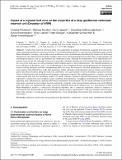Impact of a regional fault zone on the properties of a deep geothermal carbonate reservoir unit (Devonian of NRW)
Abstract
A multi-proxy field and laboratory study was conducted to investigate the impact of a regional fault zone on Devonian carbonate geothermal reservoir properties. The outcrop analogue chosen is exposed in the Steltenberg quarry (North Rhine-Westphalia, Germany) and provides access to Devonian lime- and dolostone units affected by branches of the Ennepe Thrust Fault zone. Data presented include (i) field evidence from sedimentological and structural data, (ii) petrographic and mineralogical analyses, and (iii) geochemical and petrophysical data. Although the interpretation of the depositional environment is not trivial, the carbonate facies present generally reflect the shedding of reefal material from large bioherms to the west of the study areas as well as localised, small bioherms prone to storm disintegration. The inherited properties of these carbonates at deposition, and a clear understanding of their diagenetic history, are the prerequisite for extrapolation between outcrop analogues and their corresponding subsurface units. We document a detailed interpretation of the paragenetic sequence that affected these rocks from deposition, burial, subsequent hydrothermal overprint related to rock disintegration and fluid circulation along the fault zone, and finally, late-stage meteoric overprint. Emphasis is placed on various forms of dolomitisation and its effect on rock properties and reservoir quality. The resulting scenario is complex, and when comparing the data from the Steltenberg quarry with nearby outcrops, significant regional heterogeneity is observed. It is important to separate between: (i) diffuse, locally distributed dolomitisation, (ii) replacive dolomitisation (fronts), spatially separating lime- and dolostones, and (iii) fault-bound, hydrothermal dolomitisation. The Devonian carbonates in the Steltenberg quarry examined here have higher thermal conductivity compared to the Jurassic (Malm) carbonate units in the Munich area, with some even higher than the values of massive limestone facies of the Munich area. As a large portion of North Rhine-Westphalia’s territory is underlain by Devonian carbonates, this is considered significant. However, emphasis is placed on the fact, that data shown here document the spatially complex organisation of rock types and their reservoir properties. This presents a warning against oversimplifications when extrapolating observations from outcrops into subsurface rock bodies.
Citation
Pederson , C , Mueller , M , Lippert , K , Igbokwe , O A , Riechelmann , S , Lersch , S , Benger , P , Verdecchia , A & Immenhauser , A 2021 , ' Impact of a regional fault zone on the properties of a deep geothermal carbonate reservoir unit (Devonian of NRW) ' , Zeitschrifts der Deutschen Gesellschaft für Geowissenschaften – Journal of Applied and Regional Geology , vol. 172 , no. 3 , pp. 339 - 364 . https://doi.org/10.1127/zdgg/2021/0281
Publication
Zeitschrifts der Deutschen Gesellschaft für Geowissenschaften – Journal of Applied and Regional Geology
Status
Peer reviewed
Type
Journal article
Description
Funding: This study was supported by the Interreg NWE Programme through the Roll-out of Deep Geothermal Energy in NorthWest Europe (DGE-ROLLOUT) Project (www.nweurope. eu/DGE-Rollout). The Interreg NWE Programme is part of the European Cohesion Policy and is financed by the European Regional Development Fund (ERDF). Further funding was provided by the Bundesministerium für Wirtschaft und Energie of NRW and the Ruhr-University Bochum Research Department under the Closed Carbon Cycle Economy project.Collections
Items in the St Andrews Research Repository are protected by copyright, with all rights reserved, unless otherwise indicated.

